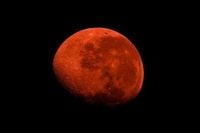On the evening of Sunday, September 7, 2025, a rare and captivating celestial event is set to unfold in the night sky—a total lunar eclipse, more evocatively known as a "Blood Moon." For those lucky enough to be in the right place at the right time, the full moon will slip into Earth’s shadow, transforming from its usual silvery-white glow to a deep, coppery red. This spectacle, visible to billions, is poised to become one of the most widely observed lunar eclipses in recent memory.
According to USA Today, the September full moon will reach its peak illumination at approximately 1:09 p.m. Central Time (2:09 p.m. Eastern Time) on September 7. This full moon, known as the Corn Moon, takes its name from the traditional period of corn harvesting in the northern United States, a nod to the agricultural cycles that have shaped human history for centuries. The Farmer’s Almanac also notes that this moon has been called the Child Moon (Tlingit), Autumn Moon (Cree), and Falling Leaves Moon (Ojibwe) by various Native American tribes, reflecting the diversity of cultural interpretations tied to lunar phases.
But what truly sets this Corn Moon apart is the total lunar eclipse that will occur on the same night. As Discover Magazine reports, the eclipse will last for nearly five and a half hours, beginning around 11:28 a.m. Eastern Time and concluding at 4:55 p.m. Eastern. The period of totality—when the moon is completely immersed in Earth’s dark inner shadow, or umbra—will stretch for an impressive 82 minutes between 1:30 p.m. and 2:52 p.m. Eastern Time. This makes it the longest Blood Moon since 2022, a detail sure to excite both seasoned stargazers and casual skywatchers alike.
The mechanics behind a total lunar eclipse are as fascinating as the event itself. As Space.com explains, a total lunar eclipse occurs only when the sun, Earth, and moon are perfectly aligned, with Earth sandwiched in the middle. The moon passes into Earth’s shadow, and as sunlight filters through our planet’s atmosphere, shorter wavelengths like blue and green are scattered away, while longer red and orange wavelengths bend around the Earth and bathe the moon in their warm glow. This is what gives the Blood Moon its signature color—a phenomenon that, as SpacePlace notes, is the same reason sunrises and sunsets often appear red or orange.
For those wondering where this cosmic show will be visible, Time and Date provides a clear answer: about 85% of the world’s population will have the chance to witness at least part of the eclipse. The best views will be afforded to observers in Eastern Africa, most of Asia, the western half of Australia, and East Antarctica, where the entire sequence—from the initial penumbral phase through totality and back—will be visible. Regions such as Europe, the rest of Africa, and the remainder of Australia will see at least some portion of the eclipse. However, there’s a catch for North and South America: the event will occur during daylight hours, making it invisible to those on the western side of the Atlantic. As Discover Magazine and USA Today both confirm, Americans will have to wait until March 2026 for their next chance at a Blood Moon.
If you’re in one of the lucky regions, you won’t need any special equipment—no telescopes, binoculars, or protective glasses are necessary. Unlike solar eclipses, which can damage your eyes if viewed without proper protection, lunar eclipses are perfectly safe to observe with the naked eye. In fact, as Discover Magazine points out, anyone in an area where it’s nighttime during the eclipse simply needs to look up to catch the show. For those unable to see it in person, live streams from platforms like Time and Date or The Virtual Telescope Project will ensure the spectacle can be enjoyed worldwide.
The timeline of the eclipse is precise. According to Conde Nast Traveler, the penumbral eclipse will begin at 15:28:25 UTC, followed by the partial eclipse at 16:27:09 UTC. The full eclipse commences at 17:30:48 UTC, reaching maximum intensity at 18:11:47 UTC, and ending at 18:52:51 UTC. The partial phase concludes at 19:56:31 UTC, and the penumbral phase wraps up at 20:55:08 UTC. These times correspond to late afternoon and early evening in many parts of the Eastern Hemisphere, so viewers should convert UTC to their local time to avoid missing the moment.
While the Corn Moon and Blood Moon are the highlights of September’s lunar calendar, the month’s other phases are also worth noting. The last quarter will occur on September 14, the new moon on September 21, and the first quarter on September 29. Shortly after the eclipse, the autumnal equinox—marking the official start of fall—will arrive on September 22 at 2:19 p.m. Eastern Time, ushering in cooler temperatures and shorter days for much of the Northern Hemisphere. Meteorological autumn, however, begins on September 1, reflecting the way scientists divide the seasons for record-keeping purposes.
For those already looking ahead, the October full moon, known as the Hunter’s Moon, will follow on October 6. And while North Americans will miss out on September’s Blood Moon, the next total lunar eclipse visible from the United States will take place on March 2–3, 2026, with totality lasting 58 minutes and visible across North America, the Pacific Islands, Australia, New Zealand, and East Asia.
But back to the Corn Moon—why does it matter so much? Beyond its agricultural significance, the Corn Moon is a vivid reminder of the rhythms that have guided humans for millennia. As Old Farmer’s Almanac details, moon names like Corn Moon, Child Moon, and Falling Leaves Moon reflect the deep connections between natural cycles and human culture. The Blood Moon, meanwhile, is a testament to the interplay of light, shadow, and atmosphere—a cosmic dance that’s as beautiful as it is predictable.
As the world prepares for this rare event, one thing is certain: whether you’re watching from a bustling city or a quiet countryside, the Blood Moon of September 2025 promises to be a spectacle worth remembering. And for those who miss it, the sky always holds another surprise just around the corner.





